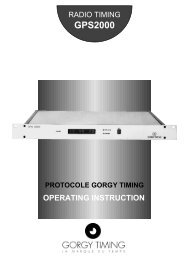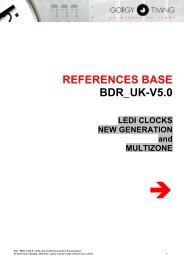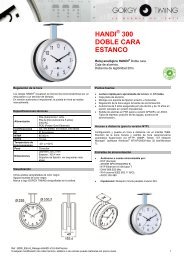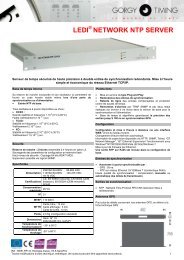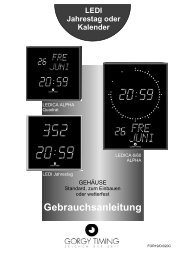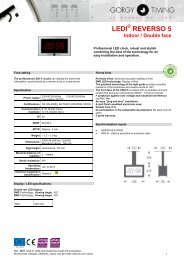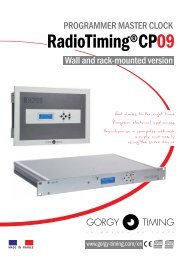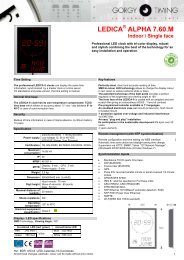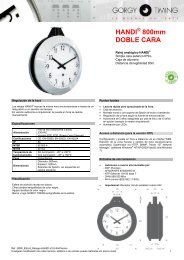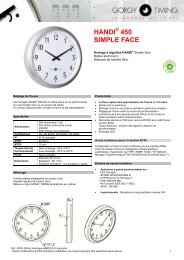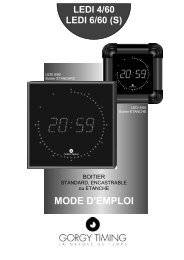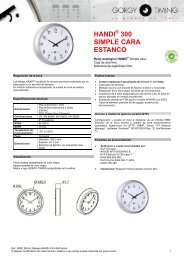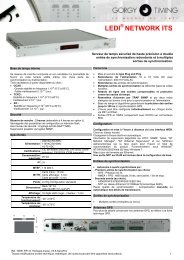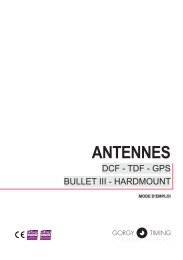LEDI 1/S BROADCAST - Gorgy Timing
LEDI 1/S BROADCAST - Gorgy Timing
LEDI 1/S BROADCAST - Gorgy Timing
You also want an ePaper? Increase the reach of your titles
YUMPU automatically turns print PDFs into web optimized ePapers that Google loves.
<strong>LEDI</strong> 1/S<strong>BROADCAST</strong>AFNOR NFS 87-500 input orRS TDF input orRS DCF inputASCII RS232 / RS485 outputDry loop ALARM outputAFNOR NFS 87-500 U.T outputAFNOR NFS 87-500 local time outputSMPTE/EBU synchronised by coded black inputUSER'S MANUALFOR19/A/305C
<strong>LEDI</strong> 1/S <strong>BROADCAST</strong>Dimensions4241U = 44263 482Front panel :ProgReset+-Clock synchronisation displayBack panel :500 mA Fuse230V AC1 8ASCIIoutputBlack burstinput1 8ASCIIconfig.AFNOR NFS87-500 orTDF/DCFradiosynchronisationinputSMPTEoutputon pins1 and 3AFNORlocal timeoutputAFNORUniversaltimeoutputProgramming ofsynchronisationtime andSMPTE config.Programmingof user bytesAlarmoutput2
<strong>LEDI</strong> 1/S <strong>BROADCAST</strong>I - DESCRIPTIONThe <strong>LEDI</strong> 1/S <strong>BROADCAST</strong> is an SMPTE/EBU code generator, with a coded black input, synchronised byeither TDF or DCF to local time, or by GPS satellites to universal time (AFNOR NFS 87-500 input).It also features an ASCII RS232 or RS485 output, an AFNOR NFS 87-500 local time output, an AFNORNFS 87-500 universal time output and a dry loop alarm output.- 7-segment, red LED numerical display with 8 digits- Display of hours, minutes, seconds and image number- Height of figures: 14 mm- Comes in a 19" standard flush-mounted unit, height 1U- 230 V, 50-60 Hz power supply- Luminosity adjustment on front panel- Consumption: 6VAIn TDF or DCF version:- dot flashing in time with the synchronisation code on start-up or absence of synchronisation code for morethan 24 hours- dot flashing at 1-second intervals during normal operation.II - CONNECTIONSConnect the necessary inputs and outputs as shown on the illustration of the back panel in I.3.Connect the 230 V 50/60 Hz supply.Connecting the ASCII RS232/RS485 output and User Bytes programming input (RS232)RS232RS4851 N.C 1 N.C2 TXD 2 TX+3 RXD 3 RX+4 N.C 4 N.C5 GND 5 GND6 N.C 6 TX-7 N.C 7 RX-8 N.C 8 N.C9 N.C 9 N.C3
<strong>LEDI</strong> 1/S <strong>BROADCAST</strong>III - SETTING SWITCH PARAMETERS(DIP switches on back panel)III.1 ASCII RS232 or RS485 outputBy default, the ASCII parameter configuration is 9600, 8 bits, no parity, 1 stop bit.Switch numberBaudrateSwitch numberParameterData format, parity,N° of stop bit1 2 34 5 6 7Off Off Off 300 Off Off Off Off 7, even, 1On Off Off 600 On Off Off Off 7, even, 2Off On Off 1200 Off On Off Off 8, even, 1On On Off 2400 On On Off Off 8, even, 2Off Off On 4800 Off Off On Off 7, odd, 1On Off On 9600 On Off On Off 7, odd, 2Off On On 19200 Off On On Off 8, odd, 1On On On 19200 On On On Off 8, odd, 2Off Off Off On 7, 0, 1On Off Off On 7, 0, 2Off On Off On 8, 0, 1On On Off On 8, 0, 2Off Off On On 7, no, 1On Off On On 7, no, 2Off On On On 8, no, 1On On On On 8, no, 2There are two possible operating modes depending on the position of switch SW8: UNI or BIOff: unidirectional mode (transmitter or receiver)On: bi-directional mode- Unidirectional mode«UNI» position (transmitter or receiver).In this mode, the time base sends the following message at the start of each second:STX day of week SP day of month/month/year SP SP hour:minute:second CRe.g. MAR 16/03/93 10:52:25 i.e. a total of 24 characters.- Bi-directional mode«BI» position.In this mode, the ASCII time message is transmitted after receiving the character «D» on the data receptionline:STX hundredths of second SP day of week SP day of month/month/year SPSP hour:minute:second CRe.g. 76 MAR 16/03/93 10:52:25 i.e. a total of 27 characters.This message indicates that it is 76/100 past the second when the character «D» is received.4
<strong>LEDI</strong> 1/S <strong>BROADCAST</strong>III.2 SMPTE output synchronisation time and parameter settingThe time code is reset in half-hour steps by using switches 1, 2, 3 and 4 as shown in the following table:SW 4 SW 3 SW 2 SW 1 Reset timeOFFOFFOFFOFFOFFOFFOFFOFFONONONONONONONONOFFOFFOFFOFFONONONONOFFOFFOFFOFFONONONONOFFOFFONONOFFOFFONONOFFOFFONONOFFOFFONONOFFONOFFONOFFONOFFONOFFONOFFONOFFONOFFONNo synchro.00 H 0000 H 3001 H 0001 H 3002 H 0002 H 3003 H 0003 H 3004 H 0004 H 3005 H 0005 H 3006 H 0006 H 3007 H 00SW5: OFF = 25 images/s. ON = 30 images/s.A rate of 24 images/s can be selected by a strap on the board.SW6 (EBU/SMPTE): OFF = EBU, ON = SMPTESW7 (Colour Frame): ON = selection of colour frame bitSW8 (PARITY): ON = inversion of phase correction bitIV - LUMINOSITY ADJUSTMENTThe luminosity can be adjusted manually with the «+» and «-» push-buttons on the front panel, by using asmall screwdriver.V - ALARM OUTPUT- No mains power- No TDF or DCF synchronisation code for 48 hours- Relay cut-off power: 30 VAVI - SETTING THE TIMEVI.1 TDF/DCF receiver versionVI.1.1 Operation in autonomous modeWhen it is first connected or after the lithium battery has been replaced, the <strong>LEDI</strong> 1/S <strong>BROADCAST</strong> works inautonomous mode until it has received the TDF or DCF radio code correctly for 2 consecutive minutes.If reception conditions are bad at the time when the unit is switched on, it can be set manually.N.B. this mode can be selected and the internal time base reset by pressing on the reset button while holdingdown the «PROG» button.The reset procedure in autonomous mode is as follows:5
<strong>LEDI</strong> 1/S <strong>BROADCAST</strong>Pressing on Display Time delay Pressing onComments"PROG""+", "-"1 "Local time" 0.5 second None Indicates local time settingNone Year 30 seconds Adjustment of last 2 digits Adjustment range from1990 to 20892 Day, month 30 seconds Adjustment of day andmonth3 Hour, min., sec. 30 seconds Adjustment of hours Seconds and minutesscroll normally4 Hour, min., sec. 30 seconds Adjustment of minutes If the minutes are modified,the seconds stay at zero5 SYn.00.00 None Flashing stop Awaiting synch.(note 1)6 SYn.SEL IMAGE 30 seconds None Synch. phase (note 1)7 "Su.Wi" Mode 30 seconds Change of mode Selection of seasonalchangeover mode :yes, auto, no (note 2)8 Start day, month 30 seconds Adjustment of day andmonthSets date for beginningseasonal changeover9 End day, month 30 seconds Adjustment of day andmonth6(note 3)Sets date for endingseasonal changeover(note 3)10 "UT"Hrs,mn,sec. 30 seconds Adjustment of U.T Setting of hours only11 (=0) Hrs,mn,sec,image None Adjustment of luminosity Return to normal displayNote 1: This stage can only be accessed if the minutes have been modified in stage 4Note 2: mode - no = no seasonal changeover- yes = seasonal changeover with programmed beginning and ending dates- auto = seasonal changeover set automatically by TDF/DCFNote 3: This stage can only be accessed if «yes» has been selected in stage 7VI.1.2 Operation in synchronised modeAfter synchronisation by TDF or DCF, programming stages 1 and 2 are only used to display the local date,but this cannot be adjusted.Stage 3 can still be accessed in order to set the local time for a particular time zone. The date is correctedautomatically, if necessary.Stages 4, 5 and 6 no longer exist.Stages 7, 8 and 9 are unchanged.Stage 10 is only used to display universal time.Comments:* After complete initialisation of the time base (reset + programming) and in the absence of any resetting inautonomous mode, the <strong>LEDI</strong> 1/S <strong>BROADCAST</strong> will be set automatically to the local French time withautomatic seasonal changeover as soon as the TDF/DCF code is received.* If the unit is set in autonomous mode, the time difference and programmed seasonal changeoverparameters will be used automatically to calculate the local time as soon as the unit is synchronised byTDF/DCF.VI.2 AFNOR UT (GPS) receiverWhen the unit is started, the AFNOR NFS 87-500 synchronisation code must be received on the input.There is no autonomous mode operation in this version.After complete initialisation of the time base (reset + programming), the <strong>LEDI</strong> 1/S <strong>BROADCAST</strong> will be setautomatically to universal time, local time being equal to UT without any seasonal changeover.Time programming is the same as with operation in TDF/DCF synchronised mode, except that there is no«AUTO» mode for programming seasonal changeovers.
<strong>LEDI</strong> 1/S <strong>BROADCAST</strong>VII – SMPTE / EBU CODEVII.1 Description - Message transmit80 BITS PER FRAME32 USER BINARY SPARE BITS16 SYNC31 ASSIGNED ADDRESS1 UNASSIGNED ADDRESSTHE UNASSIGNED BIT ISLOGICAL ZERO UNTIL ASSIGNEDRECORDEDWAVEFORMCLOCKMESSAGE TRANSMITTED INGORGY TIMING PROTOCOL1 0 1 1 0 1 1 00481216202428323640444852566064687276790011111111111101124800001020012401248124810204010200012481248102040010000124812481020010204080FRAMES UNITS1st BINARY GROUPFRAMES TENS2nd BINARY GROUPSECONDS UNITS3rd BINARY GROUPSECONDS TENS4th BINARY GROUPMINUTES UNITS5th BINARY GROUPMINUTES TENS6th BINARY GROUPHOURS UNITS7th BINARY GROUP8th BINARY GROUPSYNC WORDLONGITUDINAL BIT ASSIGNMENTSTART CLOCK EDGE BETWEEN BIT 79 AND BIT 0COLOR FRAME FLAGBI-PHASE MARK PHASE CORRECTION BIT (SMPTE)HOURS TENSUNASSIGNED ADDRESS BIT 58BI-PHASE MARK PHASE CORRECTION BIT (EBU)7
<strong>LEDI</strong> 1/S <strong>BROADCAST</strong>VII.2 Description of SMPTE message with date information0481216202428323640444852566064687276790011111111111101124800001020012401248124810204010200012481248102040010000124812481020010204080LONGITUDINAL BIT ASSIGNMENTSTART CLOCK EDGE BETWEEN BIT 79 AND BIT 0FRAMES UNITS1 st d BINARY GROUPFRAMES TENSCOLOR FRAME FLAG2 nd BINARY GROUPSECONDS UNITS3 rd BINARY GROUPSECONDS TENSBI-PHASE MARK PHASE CORRECTION BIT (EBU)4 th BINARY GROUPMINUTES UNITS5 th BINARY GROUPMINUTES TENS6 th BINARY GROUPHOURS UNITS7 th BINARY GROUPHOURS TENSUNASSIGNED ADDRESS BIT 58BI-PHASE MARK PHASE CORRECTION BIT (EBU)8 th BINARY GROUPSYNC WORDEUROPEANFORMATLEITCHFORMAT0 0 0Day ofWeekDaysunitsDaystensMonthsunitsMonthstensYearsunitsYearstensUSFORMATDay ofWeekMonthsunitsMonthstensDaysunitsDaystensYearsunitsYearstensDaysunitsMonthsunitsMonths anddays tens0Yearsunits0Yearstens80 BITS PER FRAME32 USER BINARY SPARE BITS16 SYNC31 ASSIGNED ADDRESS1 UNASSIGNED ADDRESSTHE UNASSIGNED BIT ISLOGICAL ZERO UNTIL ASSIGNEDRECORDEDWAVEFORMCLOCK1 0 1 1 0 1 1 08
<strong>LEDI</strong> 1/S <strong>BROADCAST</strong>ProtocolVII.3 Parameter setting for serial linkRate: 9600 baudFormat: 8 bitsStop bit: 1Parity: noneVII.4 Programming user bytesSends a 13-byte frame consisting of:STX Option Format Byte Byte+1 ...... Byte+7 Checksum CRwith: Option = 0100xxx1with Format = 0011xxx1= Reading frame0100xx00 = Writing frame in ASCII code0100xx10 = Writing frame in Hexa code= No date in user bytes00110010 = Date in European format00110100 = Date in US format00111000 = Date in Leitch formatWhen a request is made to read the frame, the following protocol is received:STX Byte Byte+1 ...... Byte+7 Checksum CR (i.e. 11 bits)REMARKS:In the write with date option, the format must be hexa code (bit b1 of the option is ignored).The checksum corresponds to the «exclusive or» of all bytes except the CR.When writing a frame in hexa code, all the characters from byte to byte+7 must be transcribed into ASCIIcode.When writing a frame in hexa code, all the characters from byte to byte+7 must be transcribed into ASCIIcode.When writing a frame in ASCII code, only the first four bytes are entered, and the other four filled with 30HIf the frame is rejected by the card, an NAK is sent to the PC.If the frame is accepted, an ACK is sent to the PC.VIII - TECHNICAL CHARACTERISTICSVIII.1 Time base* CMOS-HCMOS technology* 87C51 microcontroller* 32.768 kHz and 3.6864 MHz quartz* Accuracy +/-0.1 s/day in absence of synchronisation* Operating temperature range 0°C à 60°CVIII.2 - AFNOR NFS 87-500 code input* Electrical insulation of line by transformer* Input impedance 3 k ohms at 1 kHz* Input level: 2.2 V peak to peak, +10 - 40 dB9
<strong>LEDI</strong> 1/S <strong>BROADCAST</strong>VIII.3 - Synchronisation input (TDF/DCF)* Outdoor waterproof reception antenna, delivered with support and 4 metres of sheathed dual conductor.* Input frequency: 77.5 kHz (DCF) or 162 kHz (TDF).* Maximum length of sheathed dual conductor line: 100 metres.* Maximum distance to DCF transmitter (Mainflingen, near Frankfurt, Germany) or TDF transmitter (Allouis,near Bourges, France): 2000 km (this may be shorter depending on surrounding relief and atmosphericconditions).VIII.4 Power supply* 230 V +10, -15%, 50/60 Hz* Max. consumption 6 VA* Built-in interference filter* Lithium battery back-up giving more than 10 years’ independent operationVIII.5 Alarm output* No mains power* No TDF/DCF synchronisation for 48 hours* Dry loop output* Relay cut-off power: 30 VAVIII.6 - ASCII RS232 or 485 code outputOutput configured by DIP switches on the back panel* Baud rate: 300, 600, 1200, 2400, 4800, 9600 or 19200* Parity: 0, even, odd or none.* 7 or 8 bit format.* 1 or 2 stop bits.VIII.7 - AFNOR code output* Electrical insulation by transformer.* Carrier frequency: 1 kHz.* Level: 2.2 V, peak to peak, +/-10%.* Capacity per output: 500 <strong>Gorgy</strong> <strong>Timing</strong> clocks or at least 50 clocks of other types conforming with AFNORstandardsVIII.8 - SMPTE/EBU code output with RS232 input for programming user bytes* Connection to outputs 1 and 3 of AXR3 socket* Code format in conformity with SMPTE/EBU standards* Information transmitted: hours, minutes, seconds, image number and user byte* Time code synchronised by coded black input* Automatic synchronisation time set by switches* Output impedance 50 ohms* 3 possible rates: 24, 25 and 30 images/second* Programming of user bytes by ASCII RS232 input10
11<strong>LEDI</strong> 1/S <strong>BROADCAST</strong>
<strong>LEDI</strong> 1/S <strong>BROADCAST</strong>WARNINGISOLATE BEFORE REMOVE COVERGORGY TIMING RC 74 B 38 Registered trademark and pattern All modifications reserved12




